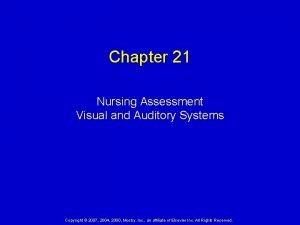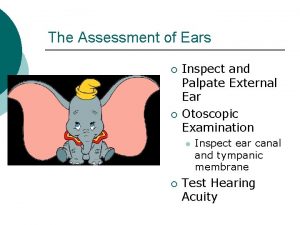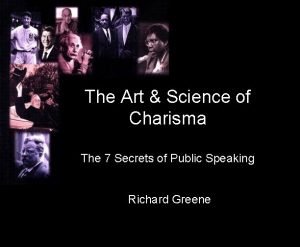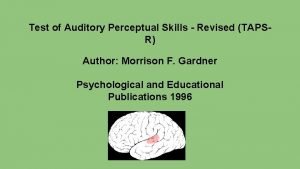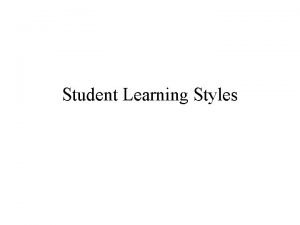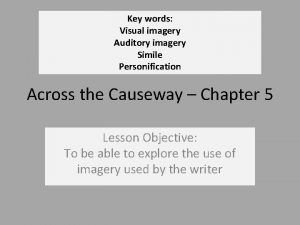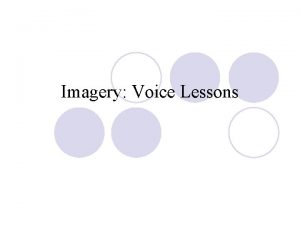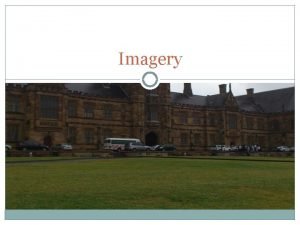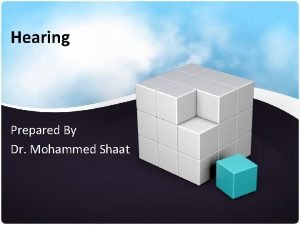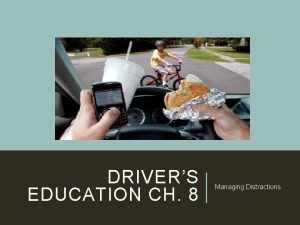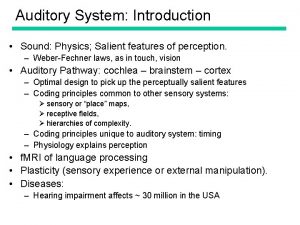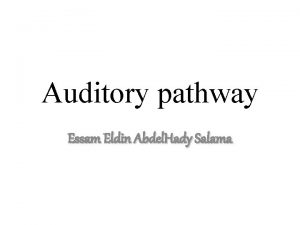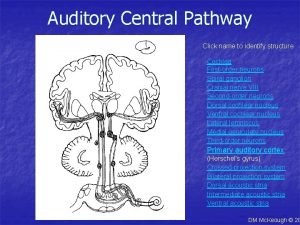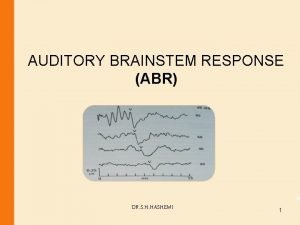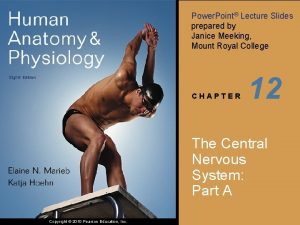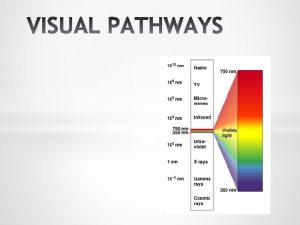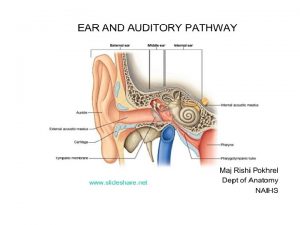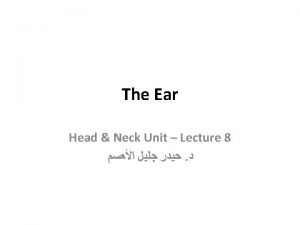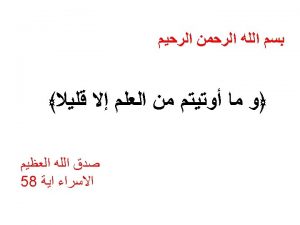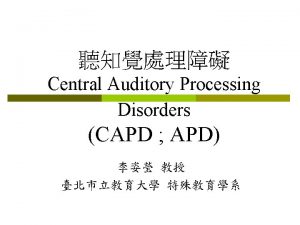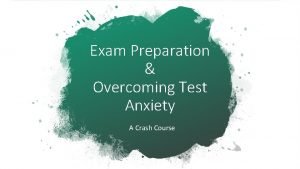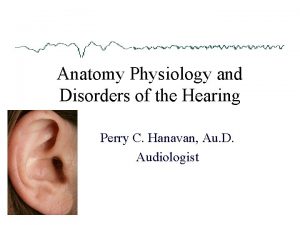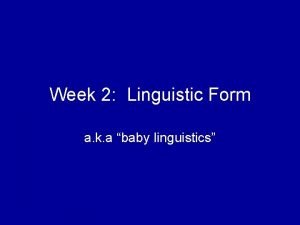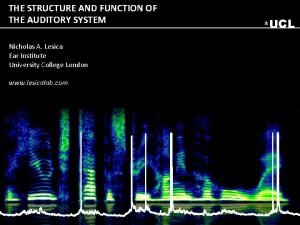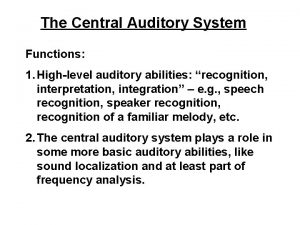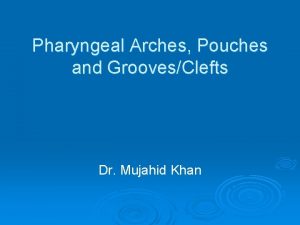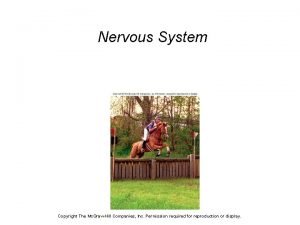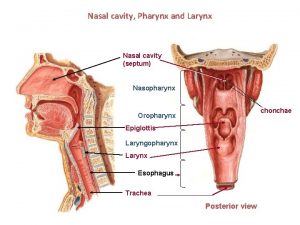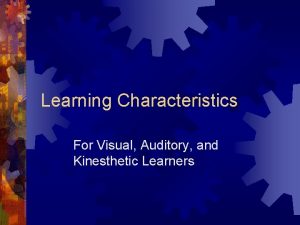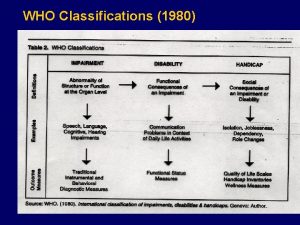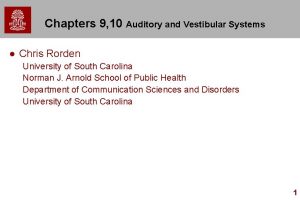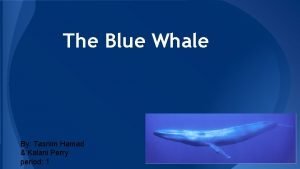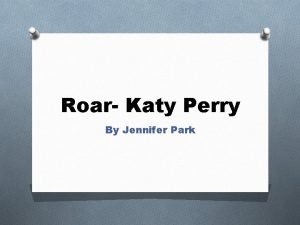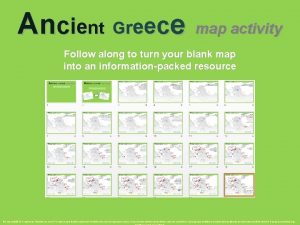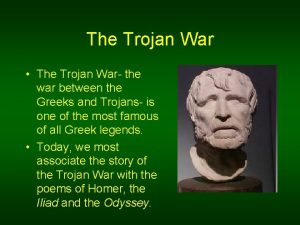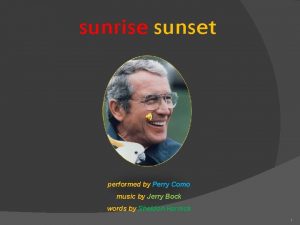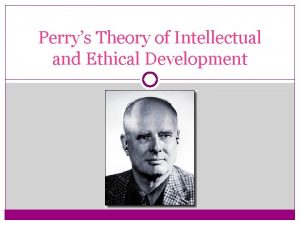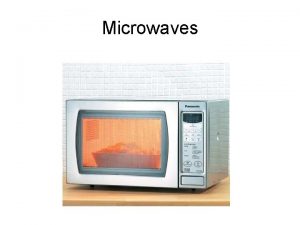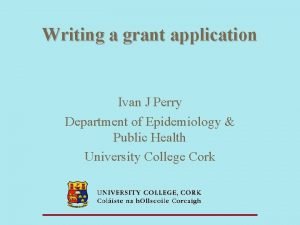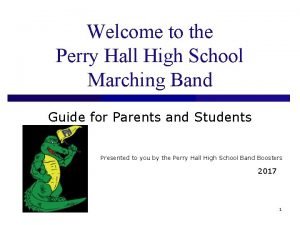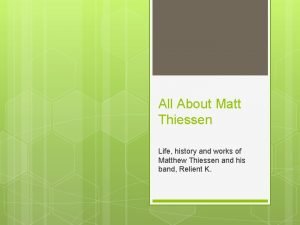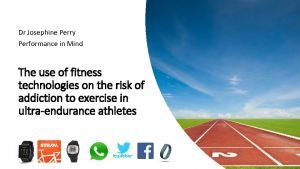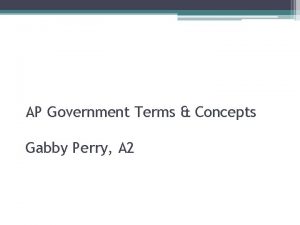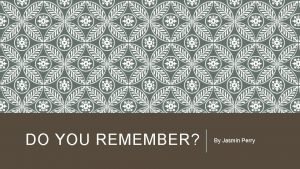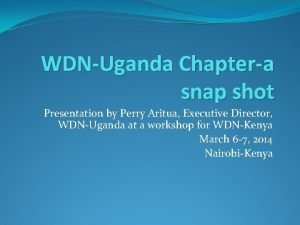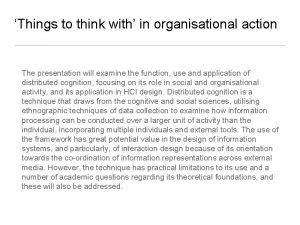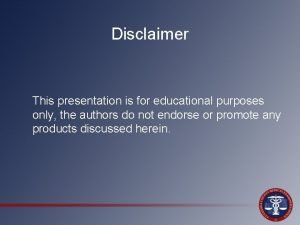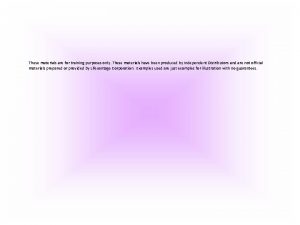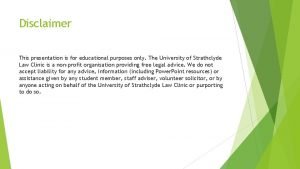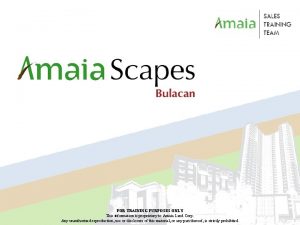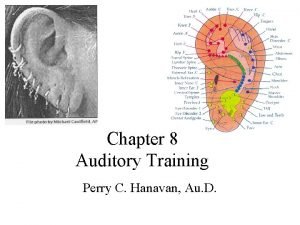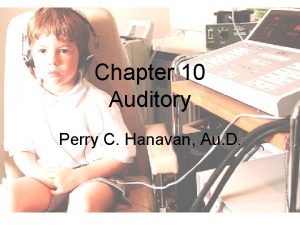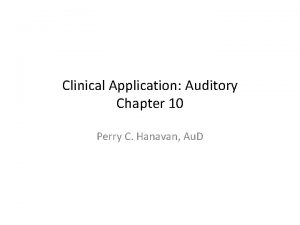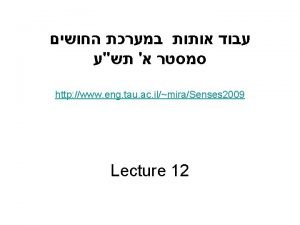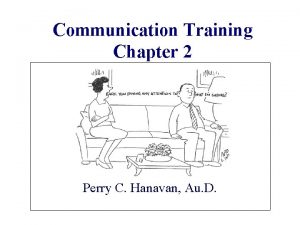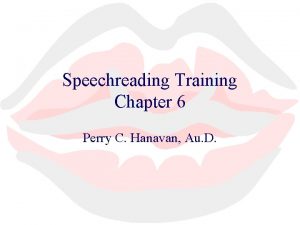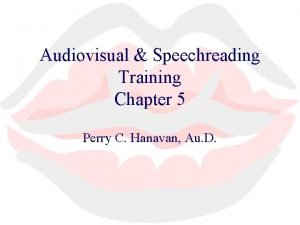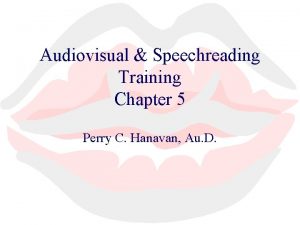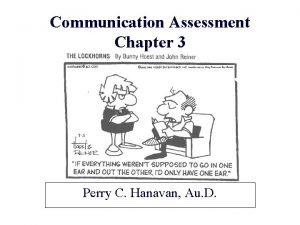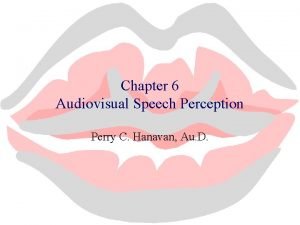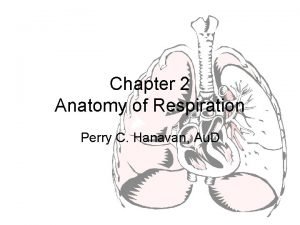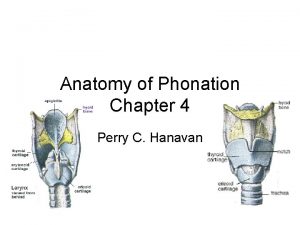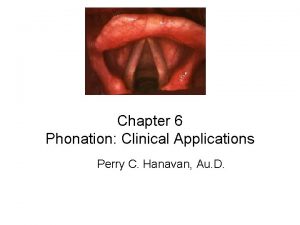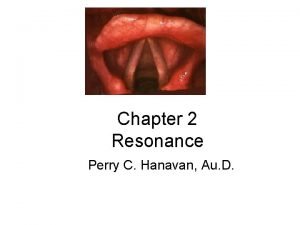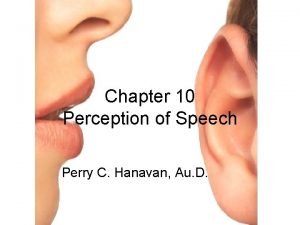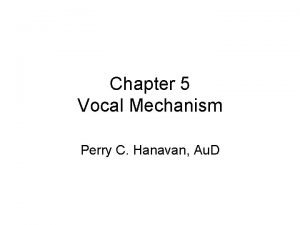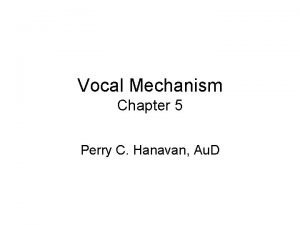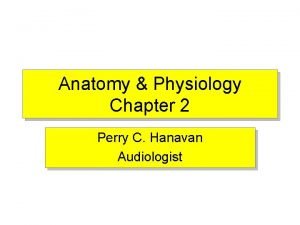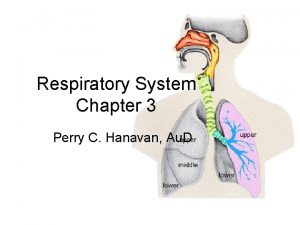Chapter 5 Auditory Only Training Perry C Hanavan
























































































- Slides: 88

Chapter 5 Auditory Only Training Perry C. Hanavan, Au. D.

? ? ? ? “You have to hear what you don’t hear to know what you don’t want to hear. ”

Factoid • 40% of 170 pediatric SNHL in study had structural peripheral auditory abnormalities diagnosed with MRI – May not have complete audibility even with best hearing aids • 50% had mal-functioning issues with hearing aids – Battery – Earmold – FM connection

Auditory Training • Utilize residual hearing • Emphasizing that the primary therapeutic goal is training the mind to be aware of, attend to, and use sound. • Speech and language activities are founded in this mental training. • To help integrate listening into one’s development of communication and social skills • To help monitor one’s own voices and the voices of others in order to enhance the intelligibility of spoken language • Utilize residual hearing with amplification and/or cochlear implant, and hearing assistance technologies

The Early Auditory Experience Hart and Risley, 1995 Welfare Words heard per hour Words heard per week Working Professional Class 616 1, 251 2, 153 62, 000 125, 000 215, 000 Words heard per year 3. 2 million 6. 5 million 11. 2 million Words heard by age 4 6. 5 million 11. 2 million 45 million

Words Understood Age 2 years 2. 5 years 3 years 4 years 5 years 6 years 7 years No. of Words 300 500 900 1, 500 to 2, 000 2, 500 to 2, 800 13, 000 20, 000 to 26, 000 Note: Between ages 5 and 6, children are learning about 28 words a day

Hart & Risely Study (1995)

The More Parents Talk to Child

Average IQ & Levels of Talk

30 Million Word Gap Initiative

LENA

LENA: Average Words Per Hour

LENA: Word & Turn Taking

LENA: TV Time & Media

Hearing Loss Impact on Phonological Processes • • • Vowel substitutions Deletion of unstressed syllable – “di(na)sour” Deletion of initial syllable of word – (e)lephant Vowel insertion - “cuppa” for “cup” Cluster reduction – “fower” for “flower” Final consonant sound deletion – “cu” for “cup”

At-Risk Language Components in Children with Hearing Loss • Plurals – Sounds like “s” (cats) – Sounds like “z” (dogs) – Sounds like “es” (horses) • Suffixes and Prefixes – Friendly, happiness – Widest, toxic – Disable, misbehave

At-risk Language Components, Cont. • Past tense – Sounds like “t” (walked) – Sounds like “d” (bobbed) – Sounds like “ed” (beaded) • Possessives – The cat’s mitten – The truck’s wheel

At-risk Language Components, Cont. • Copulas/Connecting words – – Is Of Have If • Present progressive – Going – Swimming • Pronouns and 3 rd person – He, his – She, her – It • Vocabulary!

Question Which of the following is NOT an auditory skill level? A. Detection B. Discrimination C. Recognition D. Comprehension E. Transformation

Four Design Principles 1. Auditory Skill – – Awareness, detection Discrimination Identification Comprehension 2. Stimuli – Phonetic level – Sentence level 3. Activity Type – Formal – Informal 4. Difficulty Level – Response type • – Stimulus unit • – – – Words, phrases, sentences Stimulus similarity Contextual support Task structure • – Closed, limited, open Highly structured, spontaneous Listening conditions

1. Auditory Skill Level • Awareness/Detection – Presence/absence of sound • Discrimination – Same/different • Identification – Recognition/labeling • Comprehension – Understanding/meaning detection discrimination identification comprehension

Question Analytic works on the— A. Phoneme level B. Sentence level C. Paragraph level D. None of the above

2. Stimulus Units • Analytic – Phoneme, syllable, word • Individual auditory cues • Synthetic – Sentence, communication discourse • Meaning of utterance analytic synthetic

Question The analytic approach typically begins with: A. Consonants B. Vowels C. Diphthongs D. Syllables E. Words

Analytic Auditory Approach Two primary objectives often targeted in analytic approach 1. Vowels • More intensity in lower frequencies, thus more audible to most • Vowel formants: back, front, central, high, mid, low 2. Consonants • Focus on place, manner and voicing characteristics

Vowel Formants


Question The first 2 formants are all below: A. 1000 Hz B. 2000 Hz C. 3000 Hz D. 500 Hz E. 250 Hz

Analytic Auditory Assessment Nonspeech Detection Discrimination Identification Comprehension Phoneme Syllable Word Suprasegmental

Audibility Assessment UWO Plurals Test Phonak Logatom Test Mr. Potato Head Test PBK BKB-SIN Cincinnati Auditory Test CHAPS SIFTER FLE LENA CAEP

Auditory Assessment Examples • Segmental-word: Early Speech Perception • Segmental-vowel: Early Speech Perception, Ling • Segmental-consonant: Minimal Pairs Test, Ling • Connected Speech – Mr. Potato Head Test, Common Phrase Tests (synthetic)


3. Activity Kind • Informal Training – Occurs as part of the daily routine – Often incorporated into other activities • Formal – Highly structured – Usually one-on-one training formal informal

4. Difficulty Level easy hard • Stimulus set closed limited open • Stimulus unit phoneme syllable word sentence • Stimulus similarity dissimilar similar • Context high low • Task structured spontaneous • SNR good poor

Nancy Tye-Murray: Auditory Training • cl. EAR Online Game-based Auditory Training

LACE Auditory Training: a key to hearing better in noise

Keira's therapy part 1

Auditory Oral School of NY

Brain Plasticity • Ability of brain to change • Learning possible

Plasticity • Physiological changes in the CNS (and PNS – auditory nerve) that occurs from sensory experiences – Brain’s ability to reorganize space – Benefit from HA, CI, HATs may need to be measured at later date – Brain may continue to acclimate for several years following HA, CI, HAT, therapy

Auditory Reorganization/Plasticity Cochlear dead regions Brain reorganization will occur with damage to regions of the cochlea

Dr. Nina Kraus

Dr. Patricia Kuhl

Top Down Bottom Up

Hierarchy of Listening Tasks • • • Familiar expressions/common phrases Single directions/two directions Classroom instructions Sequencing three directions Multielement directions Sequencing three events in a story Answering questions about a story Comprehension activities/exercises in noisy environs Onomatopoeic words – (Estabrooks, 1994)

Friday Morning Appointment The audiologist has just completed an audiologic evaluation and referred them for AR or you are an educator of the deaf or speech language pathologist? • What audiologic tests measure detection? • What audiologic tests measure identification?

Auditory Training Apps • • • • AB CLIX free (i. OS) AB Listening Adventures $1. 99 (i. OS) Auditory Verbal $3. 99 (i. OS) Voc. AB Scenes $1. 99 (i. OS) Hear Coach (Starkey) free (i. OS, Android) Hope Words LITE (Cochlear Ltd) free (i. OS) Hope Words (Cochlear Ltd) $2. 99 (i. OS) Hope Words HD (Cochlear Ltd) $2. 99 (i. OS) i-Angel Sound free (i. OS) i. Hear That free (i. OS) (Ling 6 Sound Game) Oceans & Continents (MED-EL) free (i. OS, Android) Rehabilitation Game (Oticon) free (i. OS) Siemens Hearing Test free (i. OS) Sound Match free (i. OS)

Analytic Auditory Training (bottom-up) Nonspeech Detection Discrimination Identification Comprehension Phoneme Syllable Word Suprasegmental

Analytic: Vowel Nonspeech Phoneme Syllable Word Detection I e i a o u tu/ti/ta tube Discrimination e vs. o tu vs. ta tub vs. tube i, u o, a ti tu to Tom Tim Tam Identification Comprehension Explain or show understan ding

More Analytic Strategies • • quiet vs. noise vs. quiet various types of noise near vs. far. . . various distances

More Analytic Strategies • • • Ling 6 sounds CAT words PBK word lists UWO Plurals Test Phonak Phoneme Test WIPI lists

Analytic Strategy

Analytic Strategy

Auditory Training: Analytic • Phonemes – common consonant confusions

Analytic • Will discriminate vowels that differ in first formant information • Will discriminate vowels that differ in second formant information (e. g. beet, bit; boot, but) • Will discriminate words that have vowels with similar first and second formant information (e. g. , “meet, mat”; boot, bought) • Will identify words with different vowels, using a four-item response set (e. g. , beet from beet, boot, bat, and bet) • Will identify words with different vowels, from an open set of vocabulary

Auditory Training Apps • • • HOPE Words i. Baldi Listen Melody Match Siemens Hearing Test Word Magic Starkey Hear Coach Auditory Verbal Sound Match Mr. Potato Head Oticon Medical-Neurelec Rehabilitation Game Minimal Pairs

CI Resources • Cochlear Americas – HOPE – School Age • Advanced Bionics – School Tools – Listening Room • Med-el – Bridge to Better Communication • Oticon Medical – Neuro – Rehabilitation

Question Which is not synthetic? A. Sentences B. Discourse C. Phonemes D. Paragraphs

Synthetic (top-down) • Will discriminate between a declarative and interrogative sentence (How are you? ; You are fine) • Will carry on a conversation • Can follow the instructions of simple commands (Go to the chalkboard; write your name on the board; jump three times, etc.

Auditory Training: Synthetic • Topic of Conversation • Sentence Matrix • Continents Listening Tasks

Analytic to Synthetic Nonspeech Phoneme Syllable Word Sentence Detection Discrimination Identification Comprehension Analytic Synthetic Discourse

Context Nonspeech Phoneme Syllable Word Sentence Detection Discrimination Identification Comprehension Low High Discourse

Stimulus Unit Nonspeech Phoneme Syllable Word Sentence Detection Discrimination Identification Comprehension Non -s pee ch D isco u rse Discourse

Audiologic Evaluation Detection Discrimination Identification Comprehension Nonspeech Phoneme Pure tone Ling 6 SAT Ling 6 Larson UWO Plurals Phonak Logatome Ling 6 Iowa Vowel Iowa Consonant WIPI NU-6 W-22 CAT SRT Isophonemic Syllable Word Sentence Discourse DSI HINT Quick. SIN BKB-SIN TOPICON

AR Evaluation (Auditory) Nonspeech Phoneme Syllable Word Detection Ling 6 Discrimination Ling 6 Larson SPAC Ling 6 NU-CHIPS WIPI CAT Identification Comprehension SPAC Sentence Discourse BKB CUNY Quick-SIN BKB-SIN TOPICON

AR Training(Auditory) Nonspeech Ling Vowel Consonant Detection Discrimination Identification Comprehension Phoneme Syllable Word Syllable forms monosyllabic NU-6 Monosyllabic trochees Spondees multisyllabic Sentence Discourse BKB CID Tracking Pitch Loudness Duration Rate noise makers everyday noises Discussion TOPICON

10 am Appointment • Early childhood program has identified a 3 year old child with profound loss which was recently fitted. Child has accepted the hearing aids and is responding to sound. • Develop 6 analytic auditory objectives from the paradigm that will encourage continued growth in exploring sound



Tongue Position for Vowels



Question What is cycling? A. Washing clothes in wash machine B. Separating trash into separate bins C. Repeating D. Reviewing a task already accomplished E. Riding a bicycle

Cycling • Reviewing or practicing tasks already accomplished or demonstrated – e. g. , student is struggling with identification of words—you review or practice at a simpler level of discrimination by comparing two words – e. g. , student is struggling with hearing comprehending sentences— you practice at a word level before returning to work with sentences

11 am Appointment • The student now 8 years of age has worn a cochlear implant since 2 and has been successfully integrated for the past three years in a regular classroom • Develop 6 synthetic objectives from the paradigm that will help the child succeed



Kid. Trax

Kid. Trax

Kid. Trax and Tes. Trax

Loudness Scales

Computer Programs

LACE Listening Demo • Click on the LACE Listening Demo http: //lacelistening. com/demo

SPATS • http: //comdistec. com

CAST • Free from Angel Sound – http: //angelsound. emilyfufoundation. org/angelsound_d ownload. html

cl. EAR • Clear Works (clear) • cl. EAR (youtube)

Mobile Apps App OS Child/ Adult Comments AB Listening Adventures i. OS C For HA or CI users, listening for word differences in both quiet & noise AB MAIS i. OS C Assess young child’s response to sound with hearing technology Oticon Medical i. OS Neurelec Rehabilitation Game A/C Practice listening to environmental sounds, detecting sounds and listening for different between speech sounds (like ba pa) Starkey Hear Coach i. OS/ A A Interactive listening games designed to challenge cognitive and auditory skills, helping improve ability to listen in noise Cochlear HOPE i. OS Words C Created to expose children to speech sounds in the English language Auditory Verbal i. OS C Ling 6 sound discrimination

Music Training with HA & CI • • • Rhythm Pitch Melody Timbre Instrument identification Name that tune
 Visual assessment nursing
Visual assessment nursing Take only photos leave only footprints
Take only photos leave only footprints Rinne test method
Rinne test method Richard greene public speaker
Richard greene public speaker Test of auditory processing skills 3 subtest descriptions
Test of auditory processing skills 3 subtest descriptions What is auditory learning
What is auditory learning Gustatory hallucinations examples
Gustatory hallucinations examples Auditory imagery
Auditory imagery Auditory imagery
Auditory imagery Examples of imagery in sinners in the hands of an angry god
Examples of imagery in sinners in the hands of an angry god Organic imagery
Organic imagery Ecolima pathway
Ecolima pathway Auditory sensory
Auditory sensory Chapter 8 managing distractions answers
Chapter 8 managing distractions answers Auditory nerve
Auditory nerve Ascending auditory pathway
Ascending auditory pathway Auditory projection pathway
Auditory projection pathway Auditory brainstem response interpretation
Auditory brainstem response interpretation Primarily seen and occupy space
Primarily seen and occupy space Premotor cortex
Premotor cortex Stapes
Stapes Lateral geniculate nucleus
Lateral geniculate nucleus Hteba
Hteba Crus of the helix
Crus of the helix Nerve to stapedius
Nerve to stapedius Dr abdel
Dr abdel Heteromodal association cortex
Heteromodal association cortex Acoustic meatus
Acoustic meatus Auditory function
Auditory function Crash course test anxiety
Crash course test anxiety Length of internal auditory canal
Length of internal auditory canal What is allomorph
What is allomorph Auditory cortex
Auditory cortex Bser aer
Bser aer Pharyngeal grooves and pouches
Pharyngeal grooves and pouches Curved
Curved Pharyngeal opening of auditory tube
Pharyngeal opening of auditory tube Visual learners characteristics
Visual learners characteristics Auditory comprehension goals
Auditory comprehension goals The seven learning styles
The seven learning styles Auditory
Auditory Kalani craig
Kalani craig Perry glasser
Perry glasser Roar rhyming words
Roar rhyming words Dr richard perry neurologist
Dr richard perry neurologist Roar figurative language
Roar figurative language Fire eaters apush
Fire eaters apush Reece map
Reece map William g perry jr
William g perry jr Was there really a trojan war
Was there really a trojan war Sunrise sunset perry como
Sunrise sunset perry como Idioms in the song roar
Idioms in the song roar Perry's theory of intellectual and ethical development
Perry's theory of intellectual and ethical development Lee burdette williams
Lee burdette williams Dr. perry sugar
Dr. perry sugar Perry grigsby
Perry grigsby Samurai ap world history definition
Samurai ap world history definition Katy perry firework figurative language
Katy perry firework figurative language Brian perry lawyer
Brian perry lawyer Importance of the study example
Importance of the study example Perry high school marching band
Perry high school marching band Spay perry county
Spay perry county Perry babb
Perry babb Matt thiessen
Matt thiessen Clarence perry
Clarence perry Dr perry liu
Dr perry liu Dr richard perry neurologist
Dr richard perry neurologist First word on the cross
First word on the cross Josie perry sports psychologist
Josie perry sports psychologist Gabby perry
Gabby perry Kuhn perry
Kuhn perry Creative commons license
Creative commons license Perry zinn rowthorn
Perry zinn rowthorn Jason perry rcc
Jason perry rcc What are sanctions
What are sanctions Jasmin perry
Jasmin perry Perry high school marching band
Perry high school marching band Perry aritua
Perry aritua Mark perry brunel
Mark perry brunel Ut tyler returning student scholarship
Ut tyler returning student scholarship Perry meridian middle school
Perry meridian middle school Education purposes only
Education purposes only For training purposes only
For training purposes only Education purpose only disclaimer
Education purpose only disclaimer For training purposes only
For training purposes only Training purposes only
Training purposes only Training is expensive without training it is more expensive
Training is expensive without training it is more expensive Perbedaan on the job training dan off the job training
Perbedaan on the job training dan off the job training Aggression replacement training facilitator training
Aggression replacement training facilitator training
